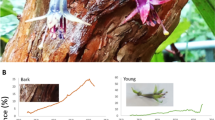Abstract
In low-density butterfly-pollinated Mussaenda frondosa (Rubiaceae), flowers attract pollinators at short distances while conspicuous, non-rewarding accessory bracts are detectable at long distances by long-ranging pollinators such as the birdwing butterfly Troides minos that did not detect flower-bearing plants in the absence of these bracts. However, even in the absence of flowers, the white, ultraviolet-absorbing bracts attracted butterflies that visited flowerless plants. Although flower visits by short-ranging territorial butterflies declined significantly on removal of bracts, they did not cease completely. Nectar-robbing carpenter bees and birds did not change their behaviour following bract removal. Bract removal caused a significant decline in fruit set, indicating their importance as visual signals to pollinators.

Similar content being viewed by others
References
Bell G (1985) On the function of flowers. Proc R Soc Lond Ser B 224:223–265
Giurfa M, Vorobyev M, Kevan PG, Menzel R (1996) Detection of coloured stimuli by honeybees: minimum visual angles and receptor specific contrasts. J Comp Physiol A 178:699–710
Herrera J (1997) The role of colored accessory bracts in the reproductive biology of Lavandula stoechas. Ecology 78:494–504
Lehrer M, Bischof S (1995) Detection of model flowers by honeybees: the role of chromatic and achromatic contrast. Naturwissenschaften 82:145–147
Ne'eman G, Kevan PG (2001) The effect of shape parameters on maximal detection distance of model targets by honeybee workers. J Comp Physiol A 187:653–660
Papaj DR (1986) Conditioning of leaf-shape discrimination by chemical cues in the butterfly, Battus philenor. Anim Behav 34:1281–1288
Silander JA (1978) Density-dependent control of reproductive success in Cassia biflora. Biotropica 10:292–296
Spaethe J, Tautz J, Chittka L (2001) Visual constraints in foraging bumblebees: flower size and color affect search time and flight behavior. Proc Nat Acad Sci USA 98:3898–3903
Stanton ML (1984) Short-term learning and the searching accuracy of egg-laying butterflies. Anim Behav 32:33–40
Waller DA, Gilbert LE (1982) Roost recruitment and resource utilization: observations on a Heliconius charitonius L. roost in Mexico. J Lepid Soc 36:178–184
Weiss MR (1991) Floral colour changes as cues for pollinators. Nature 354:227–229
Weiss MR (1995) Associative colour learning in a nymphalid butterfly. Ecol Entomol 20:298–301
Acknowledgements
We thank Andreas Gumbert for the spectral reflectance measurements; Veena C.P. for field assistance; Lars Chittka, Andreas Gumbert, Natalie Hempel de Ibarra, Almut Kelber, Peter Kevan, Michiyo Kinoshita, Doekele Stavenga and Misha Vorobyev for useful suggestions; and Almut Kelber, Natalie Hempel de Ibarra, and the reviewers for valuable comments on the manuscript. This research was funded by the Department of Science and Technology, Government of India.
Author information
Authors and Affiliations
Corresponding author
Rights and permissions
About this article
Cite this article
Borges, R.M., Gowda, V. & Zacharias, M. Butterfly pollination and high-contrast visual signals in a low-density distylous plant. Oecologia 136, 571–573 (2003). https://doi.org/10.1007/s00442-003-1336-y
Received:
Accepted:
Published:
Issue Date:
DOI: https://doi.org/10.1007/s00442-003-1336-y




